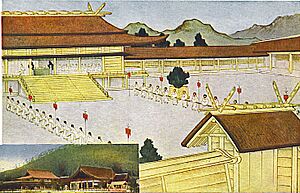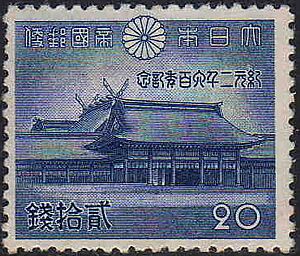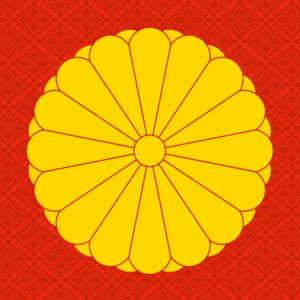Emperor Jimmu facts for kids
Quick facts for kids Jimmu |
|
|---|---|
| Emperor of Japan | |
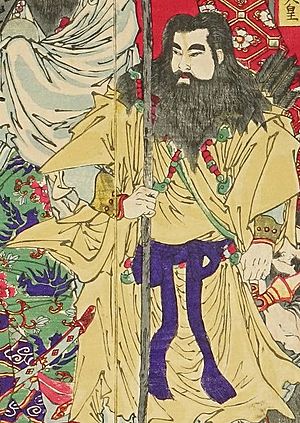 |
|
| Reign | legendary |
| Successor | Suizei |
| Born | legendary |
| Died | legendary |
| Burial | Unebi-yama no ushitora no sumi no misasagi (Nara) |
Emperor Jimmu (神武天皇, Jinmu-tennō) is known as the very first emperor of Japan. He is believed to be the founder of Japan's Imperial family.
It's important to know that there are no exact dates for when Jimmu lived or ruled. The names of the early emperors were officially recognized much later, during the time of Emperor Kammu. He was the 50th ruler of the Yamato dynasty.
Contents
The Legendary Story of Jimmu
Jimmu is mostly considered a legend. His story and family tree are written in two old Japanese books: the Kojiki and the Nihonshoki. People believe Jimmu was a direct descendant of Amaterasu, the Shinto sun goddess.
During Emperor Jimmu's time, the capital city of Japan was said to be at Kashiwabara, Yamato. This place was located near Mt. Unebi.
Jimmu's Journey and Rule
We don't have much information about the early rulers of Japan before Emperor Bidatsu. So, it's hard to say for sure if Jimmu was a real person or not.
The traditional story says that Jimmu traveled from Kyūshū to Yamato Province on the island of Honshū. The legend tells that he was guided by a special three-legged crow. He then set up his rule in Kashihara, which is close to Osaka.
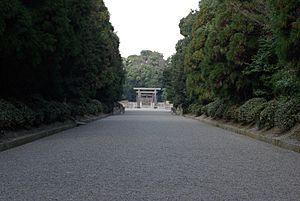
After Jimmu's Time
The official name given to Jimmu after his death (his posthumous name) was decided many centuries later. It was long after the time he was said to have lived.
The exact place where Jimmu was buried is not known today. However, the Imperial Household Agency says that he is honored at a special Shinto shrine. This memorial shrine, called a misasagi, is in Kashihara, Nara. His mausoleum is very near to the Kashihara Shrine.
A Special National Holiday
In 1872, the Meiji government announced a specific date: February 11, 660 BC. They said this was the exact day Jimmu's rule began. This date was seen as the start of the Japanese nation.
This legendary date was celebrated as a holiday called Kigensetsu ("Era Day"). People celebrated this national holiday from 1872 until 1948.
In 1940, the Kigensetsu celebrations were extra special. They marked what people believed was 2,600 years since Emperor Jimmu's reign started.
Since February 11, 1966, Japan has had a similar national holiday. It is now called National Foundation Day (Kenkoku Kinen no hi).
Related pages
| Preceded by –– |
Legendary Emperor of Japan Jimmu 660-585 BC (traditional dates) |
Succeeded by Emperor Suizei |
Images for kids
-
Emperor Jimmu, ukiyo-e by Tsukioka Yoshitoshi (1880)
-
A 19th-century artwork by Tsukioka Yoshitoshi showing Jimmu with his bow and a golden kite.
-
Unebi Goryō, the mausoleum of Jimmu in Kashihara City, Nara Prefecture
-
The inner prayer hall of Kashihara Shrine in Kashihara, Nara, the main shrine dedicated to Jimmu
-
Emperor Shōwa and Empress Kōjun at the celebration of the 2600th anniversary of the mythical founding of the Empire in November 1940.
See also
 In Spanish: Jinmu Tennō para niños
In Spanish: Jinmu Tennō para niños


